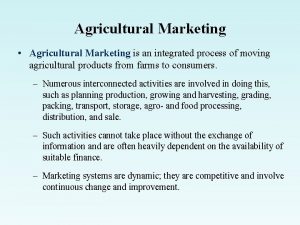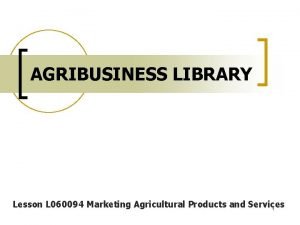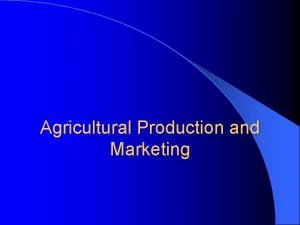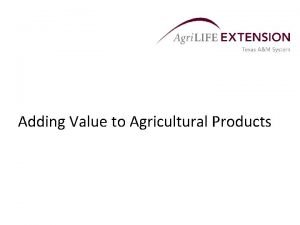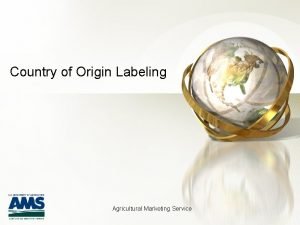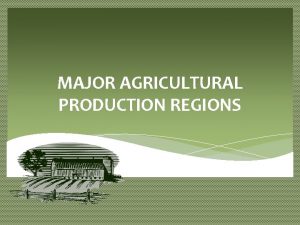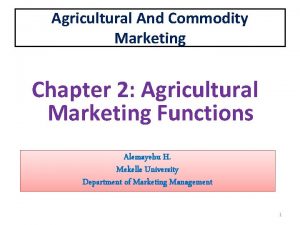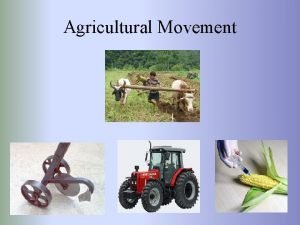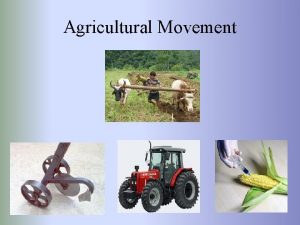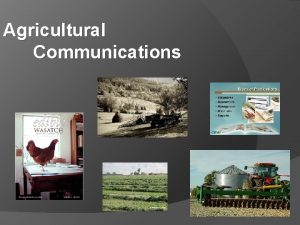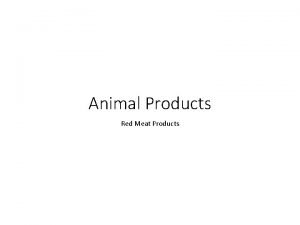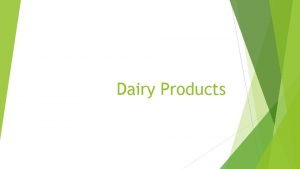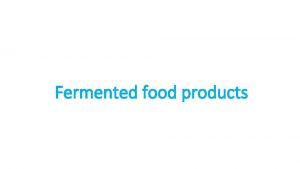Agricultural Production and Marketing Characteristics of the products




























- Slides: 28

Agricultural Production and Marketing

Characteristics of the products A raw material l The output of agriculture is largely dependent of raw material that will be used for further processing. l l This processing may be limited, as in converting livestock into meat. It may be highly complex, as in converting wheat into wheat products.

Bulky and perishable products l Compared to most other products, agricultural products are both bulkier and more perishable. Bulk affects the marketing functions concerned with physical handling. Products that occupy a lot of space in relation to their value almost automatically raise unit transportation and storage costs. l A truckload of drugs would be considerably more valuable than a truckload of wheat. In this sense, fruits, vegetables, grain, and meats are all quite bulky. l

l Perishable, too, can be measured only in relation to other products. l All products ultimately deteriorate. Some agricultural products, like fresh strawberries or fresh peaches, must move into consumption very quickly or they completely lose their value. l Such products as cattle or poultry continue to grow and change if storage in the form of withholding them from market is attempted. Wheat, on the other hand, can be stored for a considerable length of time without much deterioration.

l Even the most storable agricultural products, however, are usually more perishable than other industrial products. l Perishable products require speedy handling and often special refrigeration.

Quality variation The general quality as well as the total production of agricultural commodities varies from year to year and from season to season. l During some years the growing conditions are such that the crop in general of high quality. l In other years, unfavorable conditions prevail and the crop is much lower quality. l

Variations in the quality may also change marketing patterns. l For example, during a year in which corn does not mature properly, large amounts of ‘soft’ corn are harvested. The corn will spoil if it is not used before the following years. l Farmers may then buy additional feeder stock in order to utilize this corn. The marketing pattern of these feeders, however, will be different from the usual pattern because the feeding period is adjusted to the l condition of the corn.

Continuous consumption l Agricultural products are very important to meet daily needs of people. So, it is necessary to have regular supply of agricultural products such as food grains, fish, meat, milk, fruits etc to satisfy daily demand. l

Inelastic demand l The demand for agricultural products remains relatively less elastic. Demand for such products does not decrease or increase due to rise or fall of prices. The consumers are compelled to meet their daily needs at minimum level, even if the price of agricultural products rises up.

Price fluctuation l The price of agricultural products remains unstable. The price of agricultural products is easily affected by supply and demand.

Characteristics of production

Annual variability in production: l l l There are years where the situation of increasing, decreasing, and stable farm output. These are caused by farmer responses to prices and other uncontrollable factors such as weather and disease. Such changes in farm output influence the food marketing process and the use of the food marketing system’s capacity. Year to year changes in farm supplies have a significant impact on the purchase prices, need for storage facilities, and plant utilization rates of food marketing firms. The desire to reduce the risks and uncertainties of fluctuating farm supplies is one of the forces creating closer contractual ties between marketing agencies and farmers.

Seasonal variability in production: l l l In addition to the annual production variability, much of agricultural production is highly seasonal. Livestock receipts may vary substantially throughout the year. The harvest of such crops as paddy, fruits, and vegetables is crowded into a relatively short period. Egg and poultry production is larger in seasonal fest and remain stable after the period. To the extent that the product is storable, storage facilities must be furnished to hold the product until it is consumed.

l This means that during part of the year, storage will be used at near capacity, at other times it will be almost empty. l If the product cannot be stored it must either be processed or consumed immediately. l This may result in processing plants running at capacity for some periods and well below capacity, or even shut down, for other periods. l If the product must move directly into consumption, transportation and refrigeration facilities must be available immediately. These situations affect the costs of the marketing process.

Geographic concentration of production l Although a variety of farm products is produced in all states, there is increasing geographic specialization of farm production. l For example in Malaysia, north area tends to specialize in the production of commodities for which its resource base is best suited: paddy, fruits, etc. The marketing system, of course, must adjust to these changing geographic production patterns.

Varying costs of production: There is no single cost of production for all farmers. l Farmers cost of production are affected by climate, technology, farm size, and individual managerial skills. l Consequently, the cost of producing a farm commodity varies widely by regions and among farmers. l l Most studies have found that the average cost of farm production falls as small farms grow larger, but there is a point at which average cost do not fall further as farm size increase.

Scattered Production l Except some limited goods most of the agricultural goods are produced in all parts of the country. As farmers live scattered in different parts of the country, middlemen collect agricultural products and supply to markets.

THE FARM MARKETING PROBLEMS l The farm problem is usually associated with unstable and relatively low farm prices and incomes. l A related set of farmers’ problems can be termed the farm marketing problems, which have several dimensions.

Problems faced in the production of Agricultural goods l 1. Seasonal production l Unlike consumer goods and industrial goods which are produced throughout the year, agricultural goods can be produced only during a specific period in a year. There are summer crops and winter crops. Certain crops need lot of water. There are others that require only minimum water. In view of all these differences, all the crops cannot be grown in all the months in a year.

2. Difficult to control production l In the case of consumer and industrial goods it is possible for the producer to exercise direct control over production. But in the case of agricultural goods nature plays a vital role in production. If the cultivator has sown the seeds and is awaiting rains, failure of rains will hamper production. Agricultural production is much dependent on the availability of abundant water. Availability of water depends on rainfall.

3. Difficult to control quality and quantity of output l The producers of consumer and industrial goods can control both quality and quantity of output. It is not that easy in the case of agricultural production. Even if the producer (the farmer) uses good quality seeds, fertilizers and manures, the quality and quantity of output are determined mainly by natural factors.

4. Long waiting period l Production of consumer and industrial goods takes place almost continuously on a daily basis. But in the case of agricultural goods, the gestation period is too long. Thus, continuous production cannot be thought of.

5. Loss of crops due to pests and animals l The crops need to be protected from pests and animals. Every year, farmers suffer heavy loss of revenue due to crop loss caused by the activities of pests, insects and animals. To protect their crops farmers use pesticides, insecticides and so on. They also use electrical fences to safeguard their crops from cows, elephants and other animals.

6. Loss of production due to litigation l Another peculiar problem in agricultural production is that there is always litigation between the farmers over the land territory and other such issues. As a result, they may have to spend lot of time, money and efforts to win legal battles. This affects the time available for production and thereby affects output.

7. Small-scale production l The number of small and marginal farmers is larger than the number of big landlords. The small and marginal farmers hardly own a few acres of land. The quantity of output they turn out is hardly sufficient for their family needs. In fact, most of these people produce for their families rather than for the market.

8. Use of primitive techniques of production l In developed countries, agriculture gets the same importance that the industry gets. But in Bangladesh, although industrial development has reached a significant level, agriculture still remains a neglected sector. l The farmers follow the conventional methods of production which affect the yield. They do not have access to the latest machines and equipment because they cannot afford to have these.

9. Ignorance of the producers Producers of consumer goods and industrial goods have greater awareness than the producers of agricultural goods. As a result, the farmer can adapt to any kind of situation and come out of the problem. l For example, the producers of consumer and industrial goods can modify or update their products in time with the demand market trend. But the farmers are conservatives. They cannot adapt themselves to changes. They prefer to grow the same crop they grow every year. l

10. Lack of collective bargaining l Industrialists have their own associations through which they represent all their grievances to the Government and are able to find a solution to any problem. But in the case of agriculture, the farmers do not have any such prominent association. As a result, although they have grievances, they are not in a position to represent the same in a proper manner.
 Agricultural marketing communications
Agricultural marketing communications Marketing mix of agricultural products
Marketing mix of agricultural products Characteristics of agricultural production
Characteristics of agricultural production Pre production adalah
Pre production adalah Biofeed fertilizer
Biofeed fertilizer Adding value to agricultural products
Adding value to agricultural products Functional products vs innovative products
Functional products vs innovative products What is agricultural marketing circle?
What is agricultural marketing circle? Scope of agricultural marketing
Scope of agricultural marketing Pepsi 4ps marketing mix
Pepsi 4ps marketing mix Marketing of high technology products and innovations
Marketing of high technology products and innovations Forever presentation
Forever presentation Single channel distribution
Single channel distribution Hình ảnh bộ gõ cơ thể búng tay
Hình ảnh bộ gõ cơ thể búng tay Frameset trong html5
Frameset trong html5 Bổ thể
Bổ thể Tỉ lệ cơ thể trẻ em
Tỉ lệ cơ thể trẻ em Chó sói
Chó sói Chụp tư thế worms-breton
Chụp tư thế worms-breton Chúa yêu trần thế alleluia
Chúa yêu trần thế alleluia Các môn thể thao bắt đầu bằng tiếng chạy
Các môn thể thao bắt đầu bằng tiếng chạy Thế nào là hệ số cao nhất
Thế nào là hệ số cao nhất Các châu lục và đại dương trên thế giới
Các châu lục và đại dương trên thế giới Công thức tính độ biến thiên đông lượng
Công thức tính độ biến thiên đông lượng Trời xanh đây là của chúng ta thể thơ
Trời xanh đây là của chúng ta thể thơ Mật thư tọa độ 5x5
Mật thư tọa độ 5x5 101012 bằng
101012 bằng Phản ứng thế ankan
Phản ứng thế ankan Các châu lục và đại dương trên thế giới
Các châu lục và đại dương trên thế giới
